Tuesday April 5, 2016
For: Smart inside and out, improved dynamics, latest safety package.
Against: Feels like yesterday’s science, thinly-cushioned rear seat.
Score: 3.7/5
By Richard Bosselman
AFTER all these years and all those millions of sales, the Toyota Prius has become a known quantity and settled into a certain electric-lite pattern.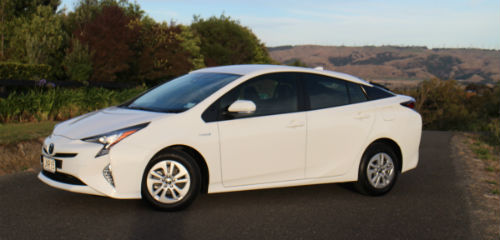
Using petrol-electric hybrid technology, a car that started out as a sedan then morphed into a hatchback has set out to provide a cleaner, more cost-effective alternative to conventionally-powered cars.
Back in 1997, it changed the world, no argument. Just obviously, though, the world is a lot different now than it was then. Motoring habits have changed and so have cars. Prius is no longer alone.
The technology it brought into this world is no longer exclusive and can be found in ‘everyday’ cars, some them Toyotas and Lexus models – not that the emergent trend of implanting batteries and electric motors into orthodox cars is a threat to Prius. Japan’s No.1 still sees benefit from having a unique hybrid car. Honda also tried this for a while and Hyundai and subordinate Kia will get into the act later this year.
People tend to forget that Prius wasn’t primarily created as a fuel-miser. It does that well enough, but the true intent by Toyota was to reduce emissions: The achieved imperative was to create a clean-air car petrol car with better thrift than a diesel and none of the smut. The latest here can emit less than 80 grams of exhaust per kilometre travelled.
NZ unfortunately doesn’t care about Co2 and exhaust nasties and, while we do think about fuel burn, we’ve also twigged that the improvements in engine design has allowed an increasing count of conventional cars that are almost as frugal but are more fun to drive and be seen in.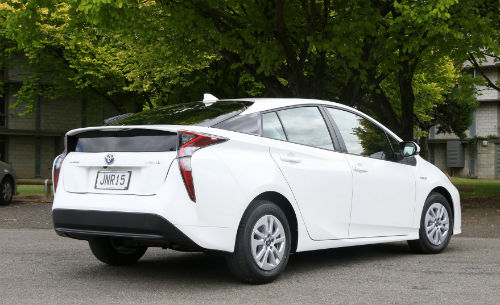
Every Prius is more economical than the last, yet even though Toyota has put more than 3.5 million Prius-badged cars on the road, in New Zealand at least, among the three products here arguably only the baby C seems to achieve real price competitiveness, undoubtedly because it recycles a drivetrain used in the second-gen Prius.
Meantime the larger hatch reminds that hybrids seem almost as expensive to develop and produce as more focused electric-first cars: So much for economies of scale.
Another point: Aren’t we also moving on? Hybrids have always been touted as a transition technology and now we’re into an age of EVs and PHEVs that can operate all day on electric urge alone then recharge back to full power overnight from a wall socket; feats Prius doesn’t offer here yet. How many people who once considered Prius are now instead looking to a Mitsubishi Outlander PHEV for little more outlay?
While it’s too soon to suggest hybrids have peaked it does seem that any love affair we have had with the car that started it all is massively diminished. Prius does well as a used import, but double registrations counts for the past two years tell a story.
Can it regain relevance? Toyota New Zealand reckons this year will bring growth – albeit modest, with just 200 sales at most predicted – and is also looking to plug into the PHEV scene with the Prius Prime, an externally-rechargeable edition just revealed internationally.
Being the first car to sit upon the latest Toyota New Global Architecture platform allows the brand to promote the 4G (because it’s the generation four) Prius as being something new. They say the new underpinning provides an ingredient some would say has been previously lacking: A fun-to-drive x-factor. How wishful is that? The GX, at $47,490 the cheapest of three versions of sale, was charged with providing some answers.
Style, specification
Styling that is distinctive to the point of causing distraction and division has always been the Prius way and nothing changes. This time, though, they asked a young crew to take charge, and it shows with a rakishness that’s a step up from the overly-safe approach previously taken.
But quirky? You betcha. The nose and tail treatments are dramatic, and if almost at odds with each other, deliver the most powerful design message attached to any Prius. Toyota claims it was answering customer demand for more dynamic styling, yet it also acknowledges wanting excellent aerodynamic effect (best evidenced on the GX, as its 15-inch rims are the smallest wheels available). Whether their achievement of a truly wind-cheating 0.24Cd demanded as much time on a Cray supercomputer as spent in the studio is not explained, but the incredible quality of the detailing suggests a definite human touch and while the car is hardly handsome, it is definitely different enough to stand out from the mainstream Toyota family.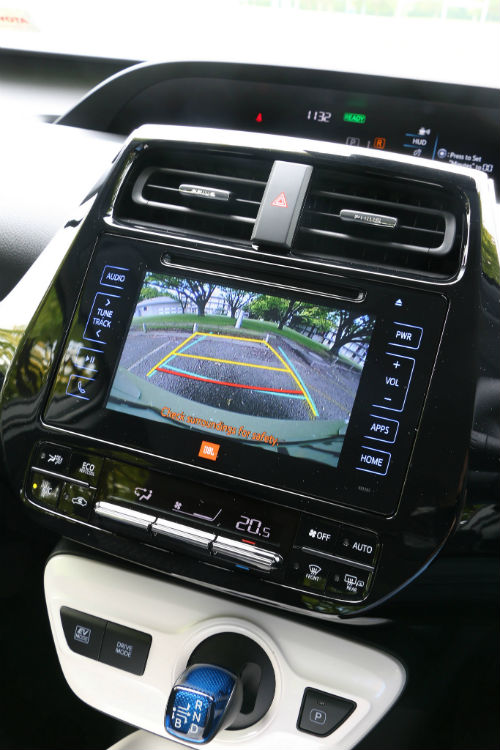
For all that it might also be considered derivative. Toyota’s other major lab rat project, Mirai, a hydrogen fuel-cell car (so not expected to be seen here anytime soon), has the same low nose, high tail silhouette, similar wraparound headlights and triangular-shaped foglights.
No prizes for guessing that the interior is every bit as futuristic as its exterior, with loads of swooping panels, more steering wheel-mounted buttons than ever, two LCD screens with acid blue displays and a centre console and gear selector surround in porcelain white, ‘Star Wars’ Stormtrooper’ plastic. Actually, evidence that someone at Toyota’s interior styling department is a George Lucas fan doesn’t stop there: The outline of the touch screen below the central instrument stack bears uncanny resemblance to Darth Vader’s helmet, yes?
It’s all a bit whacky, but the design is really solid and pleasingly easy to navigate. Just as importantly, none of the instruments are ever blocked out by your hands or the steering wheel rim.
The shape and size of the battery pack previously influenced this car’s cabin space and flexibility; but in every successive Prius these have become smaller and lighter to the point where they now slip under the back seat so have no real effect at all.
It’s become just another regular hatch, right down to having with the same split and folding seat backs and a boot that, though still shallow-floored, is big enough at 457 litres. There’s plenty of occupant room, too, though because of the body width it becomes a four seater for adults.
The GX will likely have the best chance of winning fleet business, but despite the hard-wearing cloth trim that doesn’t mean it’s sparsely specified. Anything but, in fact: Keyless entry and start-up, full electrics, dual-zone climate-control, full LED lighting, Bluetooth connectivity (and a wireless recharging pad for those smartphones that can cope), a reversing camera, head-up display and heated front seats arrive.
Previous Prius performed well in crash-testing, and the new one should be even better – not that it need end that way. Accident avoidance is the key consideration now. Range-wide fitment of an advanced crash avoidance system that provisions a pre-collision system that provides vehicle and pedestrian detection, plus lane departure alert with steering control function, all speed dynamic radar cruise control with automatic brake control and automatic high beam is a big step.
Power, performance
Nowhere does the Prius formula seem more, well, formulaic than in the engine bay. A four-cylinder petrol, nickel hydride battery-fed electric, gearless drivetrain dedicated to the pursuit of Green goodness has been the genius of Hybrid Synergy Drive all these years.
This new 1.8-litre based drivetrain seems suspiciously like the one before, save for some refinements, and it still sticks with nickel hydride batteries over lithium ion.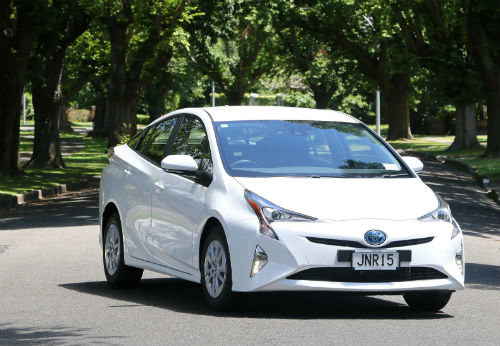
But everything has been made a touch smaller and more efficient, not least with the updated battery. It carries the same level of energy as before but is now 10 percent smaller and is capable of absorbing 28 percent more energy in the same amount of time as the previous car, allowing for faster charging while on the go.
Wand-casting over an engine related to the Corolla’s staple unit delivers friction-cheating tricks that result in it having the best thermal efficiency (energy conservation with limited loss from heat) for any petrol engine in the world at 40 percent and are responsible for a lower fuel burn (more in a moment). But the re-engineering has not made the engine itself any hotter: Maximum outputs of 72kW power, created at 5200rpm, and 142Nm of torque at 3600rpm, are modest.
The electric motor – and, yes, that’s a singular (it has two but only one contributes to motive force and the other is the generator and starter motor) – now pitches in a further 53kW and 163Nm. Which all adds up to … well, actually a total system output of 90kW power and ‘something’ torque, because Toyota doesn’t disclose a cumulative figure.
The way the drivetrain operates is as before: Basically it has the ability to work as a petrol engine, a petrol-plus-electric powerplant or just an electric motor. The car decides what works best though the driver can override its decision.
Driving
On the matter of driver engagement … well, it’s unlikely 86 owners are going to feel compelled to swap keys for a Prius, yet the proposal that the hybrid has at last finally become less an appliance created by whitecoats than an actual car is not without solid foundation.
Recognition of the importance of establishing a relationship between the driver’s input and the road is a big cut-through. It seems remarkable to suggest the rewards should start with pretty decent driving position and good steering feel, but in reality even this those were not priorities in the past.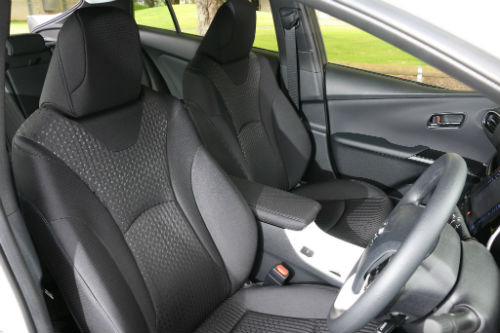
Relocating the battery set to a lower, more central position within the car is good for the handling balance and clearly this new chassis does no harm; neither, too, the fitment of a proper rear suspension.
While it’s still not an especially dynamic proposition, the ride, the turn-in, that it’s more settled on on ruffled surfaces and when pitched through corners … yes, these are also apparent and also appreciated. They’ve even given it some accelerator ‘feel’. Another big tick for that.
And, yet … well, it’s still a Prius. You can’t do anything with the gearbox because, well, it doesn’t have one. The economy-rated tyres don’t encourage too much cornering fun and, even if it did have a better grip, the overall impression remains that you are driving a distinctly nose-heavy vehicle (even though, with most of the mass midships, it’s not).
That the most extreme of the three driving modes is labelled Sport doesn’t mean much. For sure, it’s the mode that accesses a defined kick and is the antithesis of Eco, which is so terribly anaesthetized you’ll only use it in extreme circumstances, and more energetic than Normal. Yet this function was clearly not the trigger that determined some wags back in Japan to create a serious circuit racer out of this model. From my experience, nothing is. This is the story in which Clark Kent remains … well, Clark Kent. No superhero stuff here.
The enhanced dynamic delicacy clearly makes it more like a conventional hatchback, but it’s hardly set up to topple any of the obvious favourites. There’s still a softness about the car and, also, when you’re driving at open road pace, especially over hills and on winding sections, the sense that it is a large car with a small engine hauling a big battery weight continues to infiltrate.
Indeed, there’s still that sense you’re treading on eggshells when driving this car. Only when the engine is enacting does the Prius feel electric, but it has the same potential as the previous offers for the petrol-fed plant to interrupt rudely, not least when you are compelled to step off smartly. Bury the accelerator pedal away from the mark and the transmission feels like it has lost at least half of its connection with the engine, as the consequent frantic leap in engine revs and the under-floor vibration seem totally at odds with relatively leisurely increase in road speed.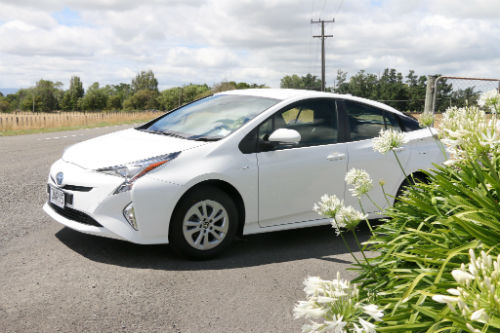
As for the other extreme? The argument that the Prius can qualify as an electric car remains totally tenuous. Toyota’s talk of it being able to travel at up to 105kmh on electric juice alone is clearly a claim based on an optimum laboratory condition. In my world, it got to about 40kmh before switching over. And that was on a flat road.
In fact, the car’s ability to do much on electric urge at all is still not brilliant. By gently moderating your right foot, you can just about drive around town purely in EV mode, but it’s always just the smallest sneeze away from capitulation and the battery-pure range is still pretty poor; maybe just 3kms at most, when at full capacity. As before, it is good for quiet getaways, but nothing much more. There’s a hill up to my place that a neighbour’s BMW i3 simply flies up without triggering its three-cylinder petrol generator. At even a crawl on a feather-touch throttle, the Toyota simply wigged out at halfway.
At least it doesn’t shock on fuel burn, assuming you play by Toyota’s rules: Drive the Prius as it was designed to be driven, making the most of EV mode, accelerating gently when engaging the petrol engine and coasting whenever possible and you’ll see some pretty impressive fuel economy. True, you will need to be something of an eco-driving whizz to hit the new factory-set fuel usage optimum of 3.4 litres per 100km (from 3.9 before), but it doesn’t take much effort to get the computer settled into a sub five litre regime. The absolute worst I registered was 5.4L/100km and that came from a totally throttle toasting run over a hilly route.
The interplay between the engine and the electrics is complex and always changing; you can see as much by watching the energy monitors that will not only show when the battery is contributing (or being fed) but also stuff like what percentage of the time the electric motor contributed during a journey.
Going quietly also ensures refinement is extremely good. Engine noise only seems to intrude under very sudden and deep acceleration while road and wind generated noises are well suppressed. It’s really good at moving quietly around the city without, despite the overt styling, drawing much attention. The car’s dimension and improved turning circle mean it can slot into pretty much any urban space now, relying on the parking aides because rear visibility isn’t good thanks to that split tailgate glass.
Verdict
The latest car is clearly better than those before it and, yes, the fresh and imaginative styling, the new chassis and the impressive kit – including those active safety features - are worth crowing about. There are some cheap touches yet it feels like it is built to last forever.
On the other hand, despite the dynamic improvement, it's still not a first choice Toyota for, say, a long trip. There’s also a sense that the Prius as a pure hybrid has entered a bit of a cul de sac; there’s no great leap forward in any area. It’s a bit like a Windows computer system upgrade; everything looks new and different and yet so much transpires to be window-dressing. The new centre screen display is a good example. Nice colours, attractive layout, more inter-active than ever and imparting a lot of information … most of which, especially the diverse economy calculations, are going to be disregarded unless you’re an absolute nerd.
The new design will turn heads. But in an age where electric vehicles are coming to the fore, the Prius has lost its technological halo. To reawaken the same level of public interest captured by the original of 18 years ago, it now demands a three-point plug and a genuine electric-only ability. It’s time for the Prius Prime.


